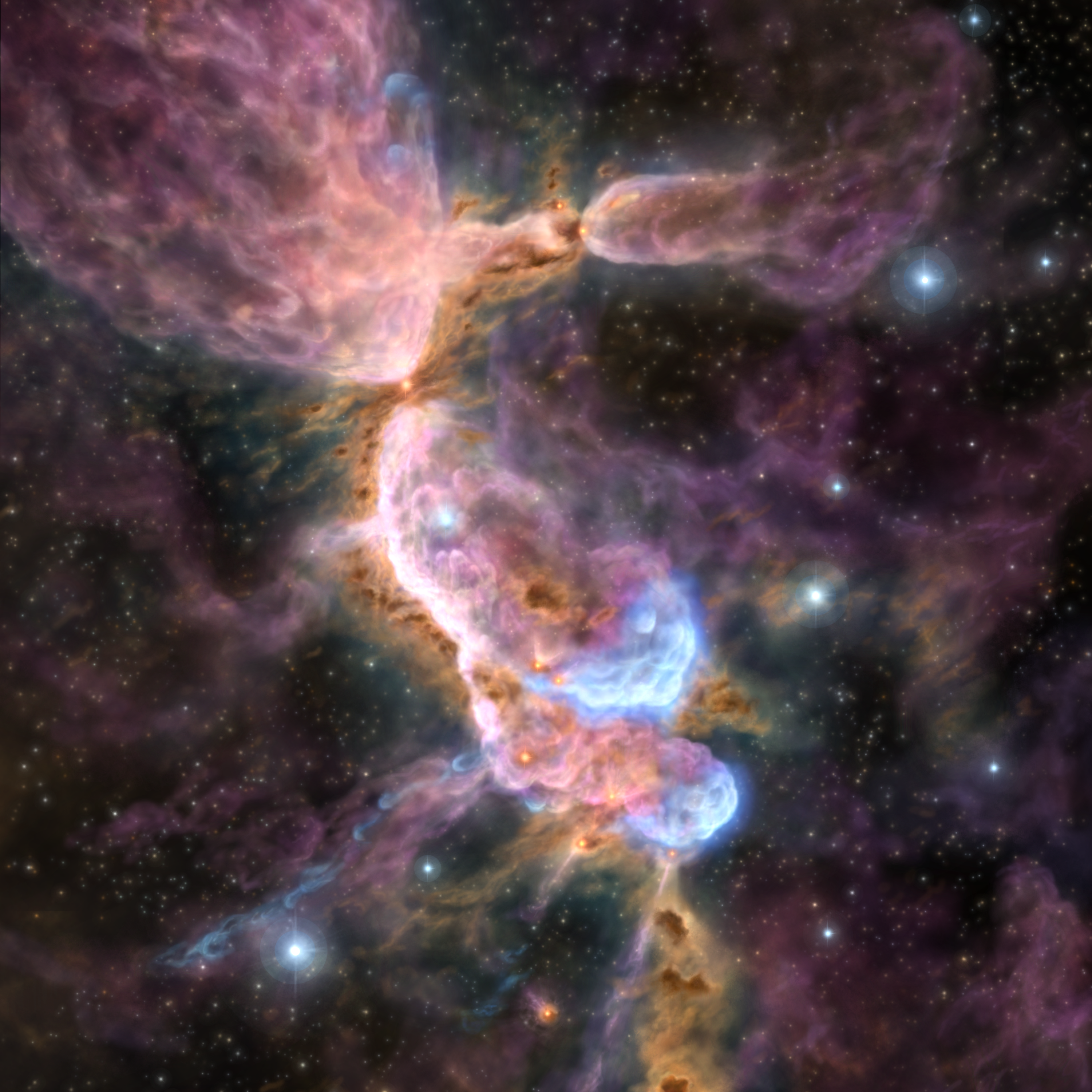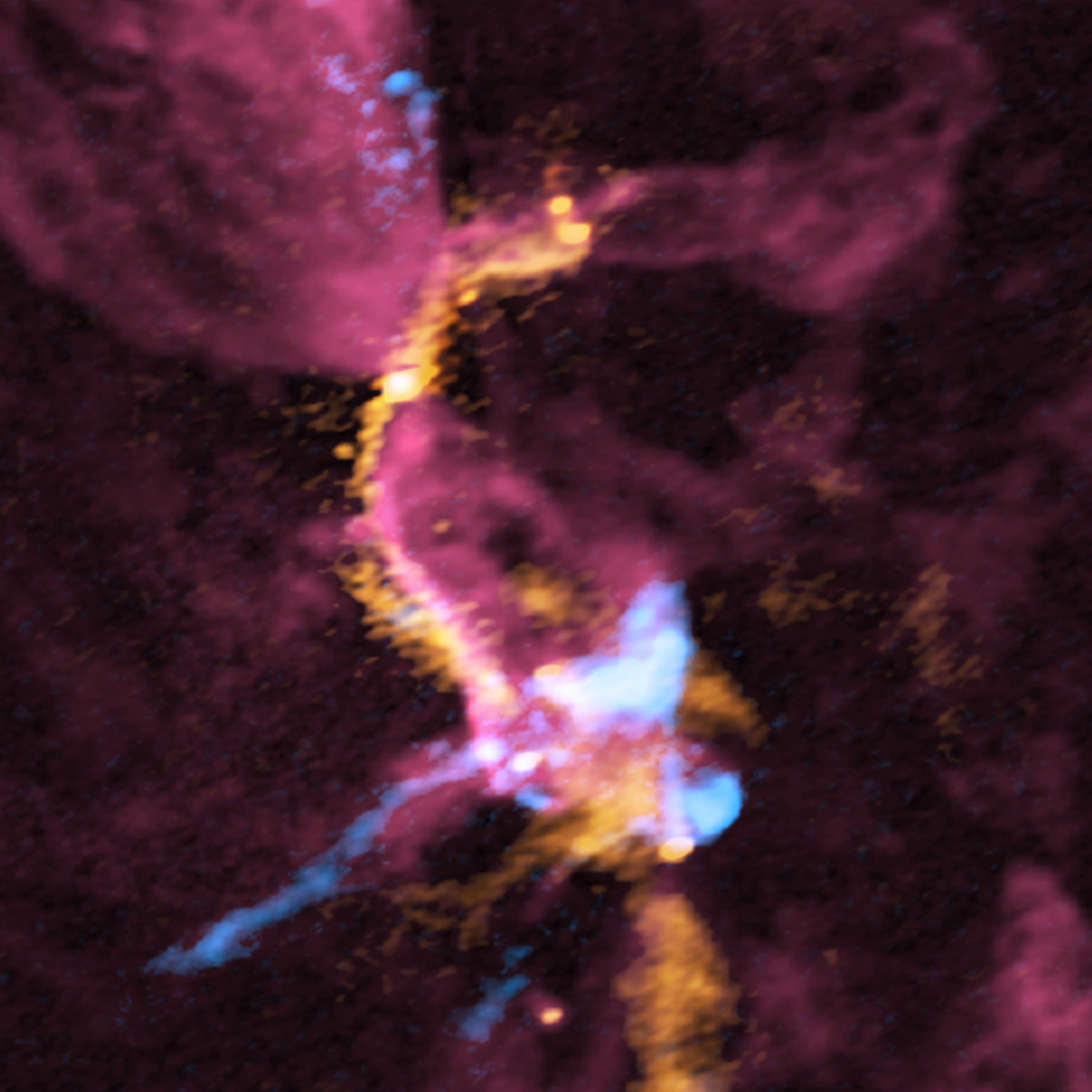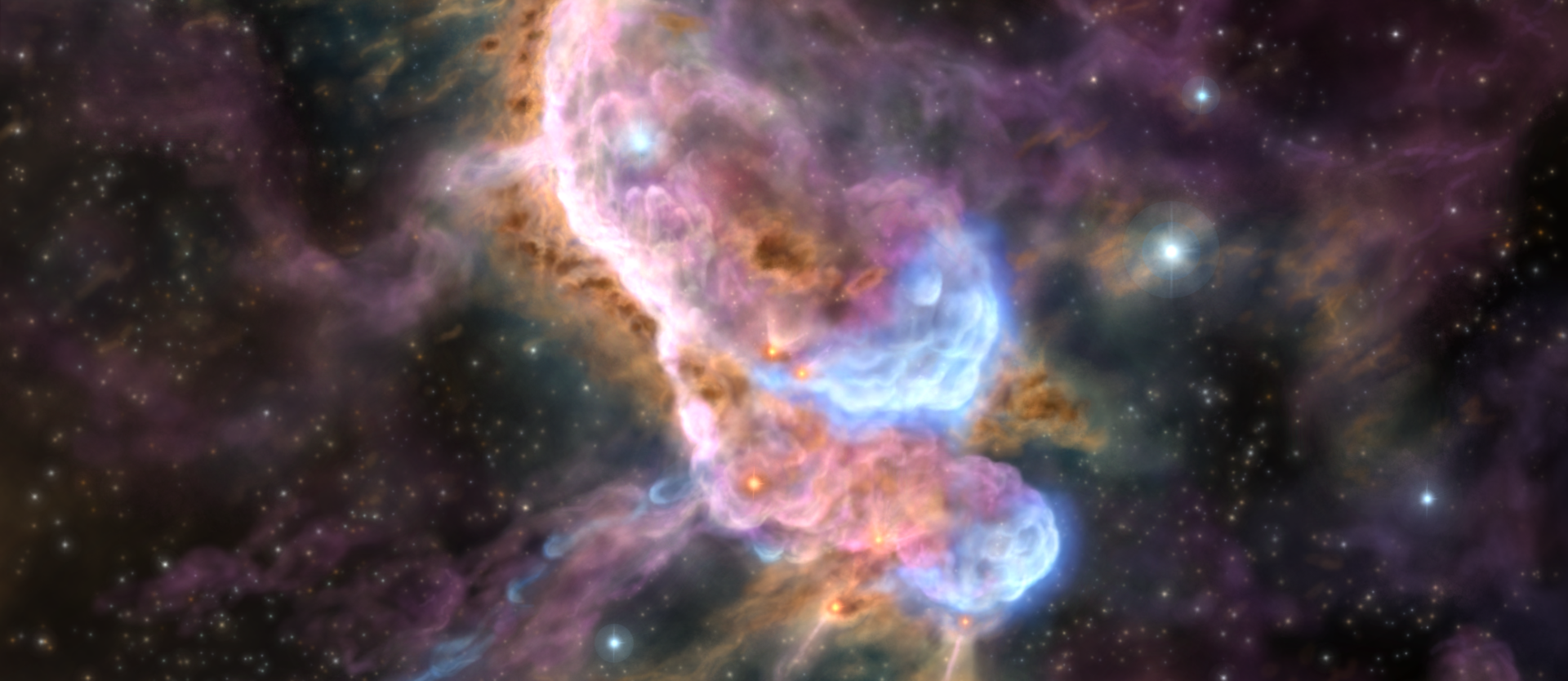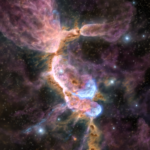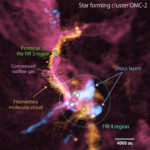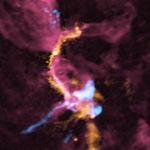Outflows from Baby Star Affect Nearby Star Formation
Astronomers revealed fast gas outflows from a baby star strongly colliding with nearby dense gas where a group of baby stars are being born. The result suggests that the outflow collision shakes the cradle of the baby stars, and has a significant impact on the ongoing star formation process. This study provides insight into the star formation process within cluster regions where baby stars are born simultaneously in a complex and crowded environment.
Baby stars (protostars) form due to the collapse of dense cores of gas and dust. At the same time, some of the material is ejected by the protostar. This phenomenon is called molecular outflow and shows a bipolar and collimated structure. The extension of the molecular outflow can be more than a million times bigger than the protostar. The molecular outflow is much easier to find than the compact and embedded protostar itself, hence searching for outflows can be a powerful tool to explore the birthplaces of protostars.
The majority of stars form together with other stars in a crowded environment called a cluster formation. Theoretical studies predict that the outflows within the star forming cluster play an important role and can themself trigger (or at least facilitate) further star-formation activity. Alternatively, ongoing star formation could be disrupted by neighboring molecular outflows. Although star formation in a cluster environment is common, observational studies that spatially resolve the individual protostars within the cluster are still limited because the target sources are located relatively far from us. The Atacama Large Millimeter/submillimeter Array (ALMA) is a powerful instrument to resolve gas and dust distributions and reveal the complex star formation processes in cluster forming regions.
Asako Sato, a graduate student at Kyushu University in Japan, and her team used ALMA to observe the regions FIR 3 and FIR 4 in the Orion Molecular Cloud -2 (OMC-2). OMC-2 is one of the nearest cluster forming regions, located at the distance of 1400 light-years away in the constellation Orion. They investigated the spatial distribution of dust and the gaseous carbon monoxide (CO) and silicon monoxide (SiO). The dust is one of the fundamental compositions to form dense material, hence a good tracer of dense cores, where protostar formation happens. CO is the second most abundant molecule in the Universe after the hydrogen molecule. CO emits strong signals in the millimeter wavelength regime and is a good tracer of molecular outflows. Emission from SiO is used to trace powerful shocked regions. A collision such as between bipolar molecular outflows and surrounding material strips silicon (Si) atoms from dust grains, which then react with oxygen (O) to form SiO. Thanks to ALMA’s high-sensitivity, this study detected twice as many molecular outflows as compared to the previous studies in the FIR 3 and FIR 4 regions.
The results show a giant molecular outflow driven by a protostar in the FIR 3 region strongly colliding with the FIR 4 region, where several protostars are being formed. The ALMA observations have clearly imaged shock layers between the molecular outflow and dense materials associated with the FIR 4 region. “The molecular outflow is proceeding from the upper left of the image, and colliding with the FIR 4 region in the bottom right. We clearly see two strong shock layers in SiO gas (which is denoted in blue color in Figure 2 within the FIR 4 region).” says Satoko Takahashi, an astronomer at the National Astronomical Observatory of Japan, and co-author of the paper. Moreover, the image shows that the CO gas within the outflow collides with the “filamentary molecular cloud” (Figure 2: presented in orange color) and is subsequently compressed (Figure 2: shown in pinkish red). The team also obtained evidence that dust within the filamentary molecular clouds can be heated by a collision with the molecular outflow. Finally, within the compressed clouds, the team detected fragmented dusty sources, which could be the cradles of the future star formation sites.
With this study, it was difficult to conclude whether star formation activities within the cluster forming region, FIR 4, were triggered by the collision with the giant molecular outflow, or if the star formation within FIR 4 had already started before the collision. “Even though the two different star formation scenarios were not disentangled, the observations clearly indicated strong shocks caused by the outflow colliding with the FIR 4 region. This means the collision must have affected the star forming activities there.” Says Sato, the primary author of the paper. She also expresses her ambition to perform future observations with ALMA to answer the questions, “How protostars in the FIR 4 region will evolve and how massive stars will form can be investigated through the dynamical motions of the gas compressed by the giant bipolar molecular outflow, which could indicate the inflow of gas toward the center of the cluster or alternatively the destruction of the cradle of the cluster.”
These observations have succeeded in directly imaging the impact of molecular outflows on star formation within a star forming cluster. Further studies will help us to understand the star formation process under the cluster forming environment.
Additional Information
This research is to be published in the Astrophysical Journal on February 14, 2023 as “ALMA Fragmented Source Catalogue in Orion (FraSCO) I. Outflow interaction within an embedded cluster in OMC-2/FIR3, FIR4, and FIR5” (doi: 10.48550/arXiv.2211.12140)
Authors: Asako Sato (Kyushu University), Satoko Takahashi (NAOJ/SOKENDAI), Shun Ishii (NAOJ/SOKENDAI), Paul T. P. Ho (ASIAA/EAO), Masahiro N. Machida (Kyushu University), John Carpenter (JAO), Luis A. Zapata (UNAM), Paula Stella Teixeira (University of St Andrews), and Sumeyye Suri (University of Vienna).
This work was supported by NAOJ ALMA Scientific Research Grant Code 2022-22B. The present study was supported by JSPS KAKENHI Grant (JP17H06360, JP17K05387, JP17KK0096, JP21H00046, JP21K03617, 20K04034), CONACyT-280775, UNAM-PAPIIT IN110618 grants, Mexico. This project has received funding from the European Research Council (ERC) under the European Unions Horizon 2020 research and innovation programme (Grant agreement No. 851435).
The Atacama Large Millimeter/submillimeter Array (ALMA), an international astronomy facility, is a partnership of the European Organisation for Astronomical Research in the Southern Hemisphere (ESO), the U.S. National Science Foundation (NSF) and the National Institutes of Natural Sciences (NINS) of Japan in cooperation with the Republic of Chile. ALMA is funded by ESO on behalf of its Member States, by NSF in cooperation with the National Research Council of Canada (NRC) and the National Science and Technology Council (NSTC) in Taiwan and by NINS in cooperation with the Academia Sinica (AS) in Taiwan and the Korea Astronomy and Space Science Institute (KASI).
ALMA construction and operations are led by ESO on behalf of its Member States; by the National Radio Astronomy Observatory (NRAO), managed by Associated Universities, Inc. (AUI), on behalf of North America; and by the National Astronomical Observatory of Japan (NAOJ) on behalf of East Asia. The Joint ALMA Observatory (JAO) provides the unified leadership and management of the construction, commissioning and operation of ALMA.
Images
